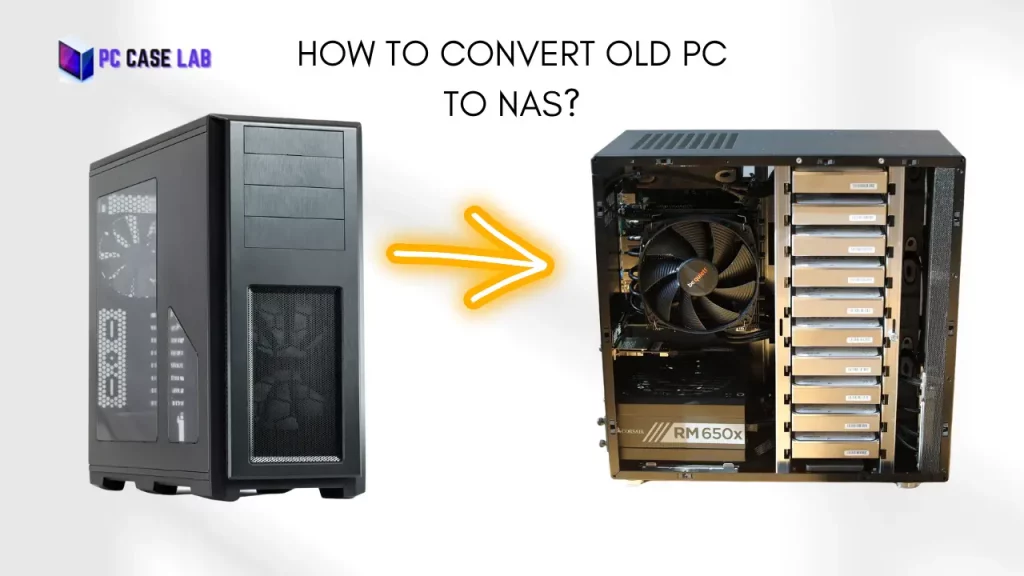There are a lot of debates on whether you should put your gaming PC on the carpet or not. Some say it’s bad for your computer, while others say it’s perfectly fine.
When configuring your PC, one of your primary choices is the ideal spot for it. Many people situate their PCs Case on a desk or table, but some opt for a carpeted area like a living room floor instead.
Allowing your PC case to sit on the carpet may appear like an easy solution, but it can prove detrimental to both the health of your computer and its longevity.
As a general rule of thumb, Placing your PC case directly on a office carpet or floor is a bad idea. The carpet fibers and more dust particles can get inside the case leading to overheating issues due to bad ventilation and, ultimately, performance loss. Therefore, you should place your PC on a clean and flat surface it regularly to avoid performance loss and damage.
Why Its Not A Good Idea To Put Computer On Carpet?
Are you ready to delve into the fascinating world of PC care and maintenance?
Let’s start with a not-so-fun fact: carpet fibers generate static electricity, which acts like a magnet for pesky dust particles.
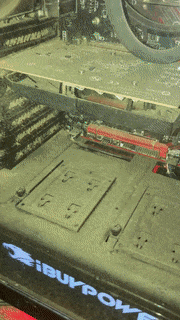
When these particles accumulate in your PC case, they can wreak havoc on its internal components and cause air vents to become clogged.
And trust me, you don’t want clogged air vents in your PC case.
Why, you ask? Well, this can make your intake and exhaust fans or radiators work harder to draw in airflow, resulting in your gaming PC generating more heat and working overtime to keep things running smoothly.
Although pre-installed fans in cases can be convenient and cost-effective for some PC builds, it’s important to keep in mind that these fans are often designed to fit a budget rather than provide optimal airflow.
This can cause your components to fail prematurely and even lead to your PC overheating, which is never good. Overheating can cause a myriad of issues like less performance potential, random shutdowns, and the dreaded inability to boot up.
A PC placed on a carpet can create a dust buildup in the power supply unit (PSU) due to the carpet fibers and dust particles being pulled into the power supply fan. As the PSU fan draws air into the unit to cool it down, it also sucks in any dust or debris in its path, including those trapped in the carpet fibers.
But wait, there’s more! The static electricity generated by carpet fibers can also cause harm to your beloved PC.
This unpredictable interaction can result in short circuits or hardware components malfunctions that no one wants to deal with. Plus, PC cases were not designed to be placed on carpets or floor due to their uneven texture, which can damage the case over time if it’s moved around too much.
The Result Of A Reddit Thread Among PC And Gaming Enthusiasts Regarding PCs on Carpets.
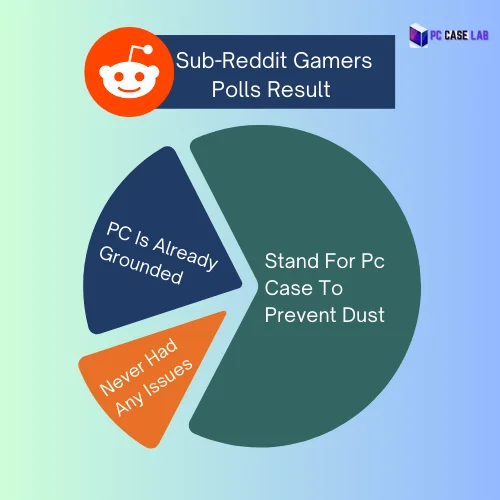
The original poster (OP) was fretting over the possibility of static electricity damaging their precious machine’s delicate components on reddit.
A few savvy users suggested using an anti-static mat or swapping out the carpet for a wooden or plastic surface.
On the flip side, some argued that if the PC is grounded correctly and the user isn’t wearing any statically-charged clothes, there’s no need to worry about the carpet causing any damage.
And then others had personally placed their own PCs on the carpet without incident.
So, in a nutshell, the thread brings up the importance of preventing static electricity damage but also suggests that there’s no reason to fear to computer placed on carpeted surface as long as you’re adequately grounded.
Putting Gaming Computer On Your Carpet Can Cause
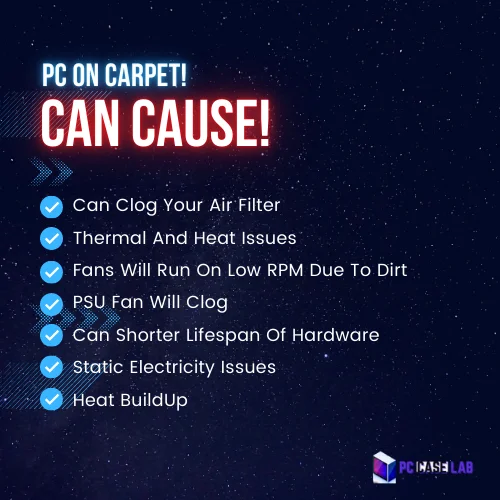
1- Static Electricity On Carpets
Putting a PC case on a carpet can cause static electricity due to the friction between the case and the carpet.
When two materials rub against each other, they exchange electrons, which can result in a buildup of static charge.
Carpets tend to generate a static charge, which can then build up in the PC case if it is placed on the carpet for an extended period of time.
This can potentially damage delicate electronic components in the PC, and may also cause problems with peripherals such as mice and keyboards.
Therefore, it is important to avoid putting a PC case on carpet if possible.
2- Dust Particles and Airflow Issues
PC on a floor can cause airflow and dust issues. This is because a carpet’s fibers can block the base of the PC and stop the intake and exhaust fans air, which is essential for cooling the system.
Dust particles are also more likely to accumulate on a carpet, which can be sucked into the PC and clog dust filters and internal components, affecting performance and lifespan.
3- Heating and Thermal Issue Heat Buildup
Building a PC on a rug is not recommended as it can cause heat issues and thermal throttling to the PC’s hardware components.
This is because the carpet can block airflow to the PC’s components, which can lead to overheating.
The PC’s components generate heat when in use, and this heat needs to be dissipated to prevent physical damage.
The carpet can act as an insulator and prevent the heat from escaping.
Over time, this can damage sensitive PC hardware components like the CPU, GPU, and hard drives, which can cause irreparable damage and affect the performance of the PC.
It is also important to ensure that the thermal paste used on the PC’s CPU is not expired or dried out, as this can also cause heating issues. To learn more about the dangers of expired thermal paste, check out our article on : When Thermal Paste Expires
4- Aesthetic
Computer case on floor can have an adverse effect on the overall aesthetics of a workspace.
The carpet creates a texture that contrasts with the sleekness of most computer hardware. Additionally, it can make the computer appear bulky and out of place.
For an optimal aesthetic, it’s recommended to place a computer on a smooth and even surface that compliments its design.
5- Corrosion Damage
Dust particles can build up over time and lead to corrosion of the metal components inside the PC.
Additionally, if the carpet is located in a humid environment, moisture can accumulate in the PC, further accelerating the corrosion process.
High levels of humidity can also cause condensation, which further increases the risk of component damage. .
Cable Management Issue On Carpet
Positioning a computer on a carpet can be problematic for cable management. Cables can become tangled and messy, creating hazards such as tripping or damaging the cables. It can also be challenging to disconnect them when needed.
Additionally, a short circuit in cables can cause an electrical fire. Avoid placing your computer on the carpet to prevent these potential hazards and ensure the smooth functioning of your computer
Potential Damage To The Carpet From The Overheating
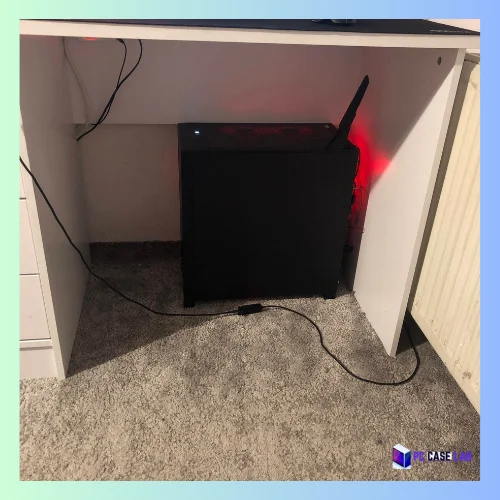
Let’s talk about the potential problems that arise when you place your precious PC on the dusty carpet or floor. It’s not just about the physical weight crushing the fibers and leaving indents that never disappear. Oh no, there’s more to it than meets the eye.
You see, the heat your computer generates can wreak havoc on your cozy floor covering. We’re talking discoloration, melting, and all sorts of unsightly damage. And don’t even get me started on the dust particle density and dirt that love to accumulate underneath your machine! Good luck getting those out without damaging the rug further.
And let’s remember the fact that excessive heat can make the carpet fibers more brittle, leading to breakage and an overall shabby appearance.
So, if you want your carpet to stay pristine and your gaming PC to stay cool, it’s time to rethink that floor-level setup.
Recommendations For Alternative Places To Put Your PC
If you find yourself seeking an alternative to the not-so-ideal placement of your precious tower PC placed on a carpet or floor, fret not.
There are numerous options to explore that will keep your system clean, cool, and in tip-top shape.
First and foremost, the obvious solution is to place your computer on a desk or table. These flat surfaces present a clean slate that is quick, easy to tidy up, and will safeguard your PC from pesky dust particles and debris.
Plus, the ample space for cable management will keep your work surface clutter-free and your PC running like a well-oiled machine.
If you want to take it up a notch, consider investing in a PC stand or case specifically designed for computers.
These solid and stable structures offer a sturdy foundation for your PC and cable management features to ensure that your cords stay tidy and organized.
If you really want to go above and beyond, consider adding an antistatic mat to your protection arsenal.
These mats are designed to reduce and minimize static electricity and protect your PC’s delicate components from damage.
They also offer a firm, flat surface for your computer to rest on, reducing dust accumulation and promoting proper good airflow to help keep your device from overheating.
The options are plentiful. So whether you choose to go with the traditional desk or table or explore some of the more advanced solutions, you can rest easy knowing that your PC is in good hands.
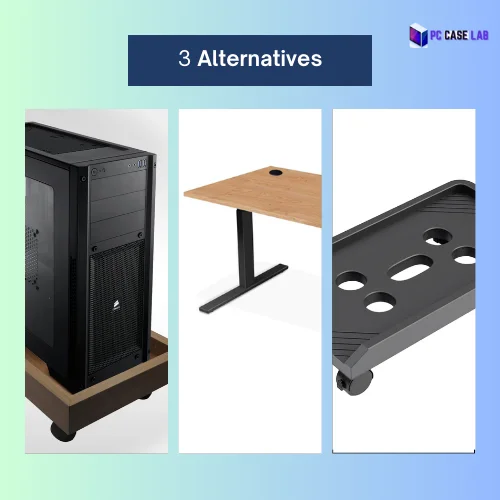
Desk or table: Regarding PCs, desks and tables make the perfect home. Their flat surfaces are simple to clean and don’t accumulate dust or debris. It is ideal for keeping your PC cool while limiting overheating risks. And with plenty of space for cable management, you can maintain an orderly work surface without sacrificing performance.
Antistatic mat: If you want an additional solution, consider investing in a static-dissipative antistatic mat. These mats reduce static electricity that could damage your PC’s delicate components and provide a firm and flat surface upon which to place your computer. Additionally, the mat reduces
Why You Should Keep Your PC Clean?
No matter where you place your PC, keeping it clean and dust-free are important. Dust can clog up the fan vents and limit airflow, preventing proper device cooling and risking overheating damage.
As such, frequent cleaning should ensure that your PC stays at its optimum performance level. It is best to use a vacuum cleaner and compressed air for this purpose, as these tools can reach all the hard-to-reach places in your PC and clear out dust and debris. Additionally, if your PC gets a lot of dust, it is better to clean it every month at least.
If dust particles are more prevalent in the air, they can negatively affect a computer system. Dust can accumulate on internal components such as the CPU, GPU, and motherboard, which can impede airflow and cause the system to overheat. This can lead to performance issues, hardware failures, and even permanent damage to the computer.
If you’re feeling daunted by the prospect of cleaning a dusty PC, have no fear. Here are some tips to help you get the job done right:
- First, shut down your computer and unplug it from the power source. Safety first, after all.
- Once your computer is safely unplugged, it’s time to grab a can of compressed air and get to work. Blow away any dust and debris lurking inside your PC, paying particular attention to areas like the fans, heat sinks, and power supply. Trust us. Your computer will thank you for it.
- Don’t be discouraged if stubborn dust particles are clinging to your PC’s innards. A soft-bristled brush or a microfiber cloth can work wonders in removing them. Keep at it until your computer is looking good as new.
- Now it’s time to turn your attention to the outside of your PC. Grab a mini vacuum cleaner with a soft brush attachment and carefully remove any dust from the vents and exterior of your computer. This may take a bit of elbow grease, but the result will be worth it.
- If your computer is looking a bit worse for wear, a mixture of rubbing alcohol and water can help to remove stubborn stains or grime. Apply the solution with a soft cloth and watch those blemishes disappear.
- If your computer has air filters, now is the time to replace them. Your PC will run more smoothly and efficiently as a result.
- Finally, avoid touching any electronic components with your fingers, and double-check that all components are dry before reassembling your computer and plugging it back in.
It is commonly advised to raise it a few inches above ground level to avoid any unpleasant accumulations of dust and debris.
The gap between a PC and the wall behind it is determined by many factors, including the PC’s dimensions, the cooling mechanism employed, and the space available in the room. As a rule of thumb, it is recommended to maintain a minimum separation of several inches between the PC and the wall to enable the proper circulation of air and optimize ventilation.
Conclusion
When it comes to placing a PC case on a carpeted surface or floor, it’s not just a matter of convenience. No, no, no. You see, it can present a myriad of challenges that require your utmost attention. We’re talking about dust and debris accumulation, tangled cables, and the increased risk of overheating and damage to internal components.
Your PC’s performance and longevity can be significantly impacted by the surface on which it sits. Yes, you heard that right. So, it’s essential to take the time to consider your setup and choose the best surface for your PC.
I am a PC enthusiast with a passion for gaming and all things tech. With years of experience building and customizing PCs, I have become a go-to source for PC case reviews and gaming insights. I am dedicated to researching and writing about the latest trends and developments in the PC gaming industry, with a particular focus on PC cases. From budget-friendly options to high-end builds, I have the expertise to guide you through the process of selecting the perfect case for your needs. Whether you’re a beginner or a seasoned pro, my in-depth reviews and practical tips will help you make an informed decision.



